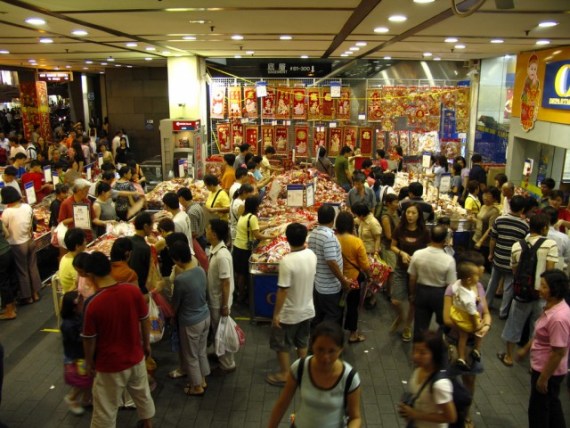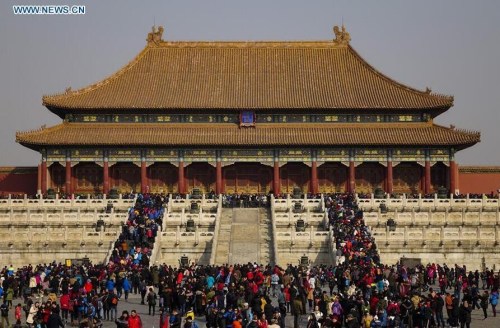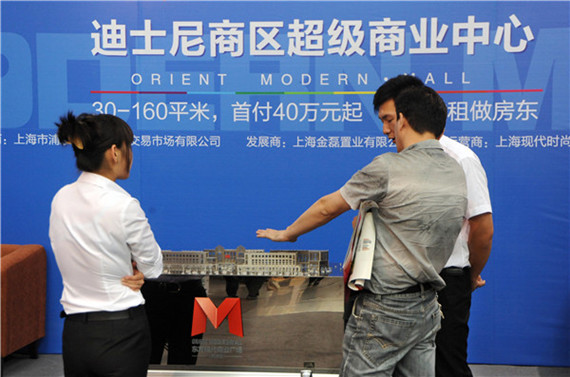Dining, shopping and traveling lead in Spring Festival spending
February 16th, 2016
Customers do shopping for the Spring Festival at a supermarket.
(ECNS) -- China UnionPay transactions soared to a record high in the week-long Lunar New Year holiday, with dining, shopping and travelling being the dominant elements, the operator revealed.
The total volume of transactions at home and abroad through China UnionPay cards amounted to 312.1 billion yuan ($47.6 billion), up 31 percent year on year. The total number of transactions reached 307 million, an increase of 15 percent, during the holiday from Feb. 7 to Feb. 13.
Card payments in supermarkets, on large household appliances and general merchandise continued to show robust growth, up 41 percent, 22 percent and 13 percent respectively.
Card spending in restaurants grew by 6 percent while the average spending was 585 yuan during this time. Guangdong, Shanghai, Beijing and Jiangsu led the country in terms of catering expenses, according to the report.
Data analyst Chen Han of China UnionPay said people usually prefer high-end restaurants and spend more during the most important festival in China.
Travelling was also popular in the seven-day holiday, with the volume of ticket purchase transactions in aviation, railway and highway passenger transportation increasing by 39 percent, 39 percent and 98 percent respectively.
One notable change is increased spending at gas stations by cardholders, at a growth rate of 39 percent, while it shows more people chose traveling by driving cars themselves, according to Chen.
An analysis of overseas card use found that more Chinese tourists spend the holiday in countries along the "Silk Road Economic Belt and the 21st-Century Maritime Silk Road," inlcuding Kazakhstan, Malaysia, Vietnam and Cambodia.
Spending witnessed a peak in the run-up to Spring Festival while the daily volume of transactions hit a record of 29.5 billion yuan on Feb 1.
China UnionPay is solely responsible for bank card transactions on the Chinese mainland and has extended its network to 150 countries and regions.
China's major coal-production region slashes overcapacity
February 15th, 2016Guizhou, one of the country's major coal-producing provinces, shut down 183 mines in 2015 in a bid to cut obsolete capacity, according to local authorities.
Through closures, mergers and acquisitions, Guizhou has reduced its number of collieries in operation and under construction to less than 800 from about 1,700 since 2013, said a spokesman with the provincial energy administration.
It aims to close more than 80 others this year, said the spokesman.
Guizhou is the largest coal producer in southern China, with the country's fifth largest proven reserves. The province's move is part of a national campaign to cut overcapacity amid dwindling demand in the coal industry.
Earlier this month, the State Council issued a guideline saying no new coal mines would be approved in the following three years and the country will shut down 500 million tonnes of capacity and consolidate another 500 million tonnes into the hands of fewer but more efficient mine operators in the next three to five years.
Another coal-producing giant, north China's Shanxi Province, has decided to keep production under 1 billion tonnes per annum for the next five years. Its production in 2015 amounted to 944 million tonnes.
Shanxi has produced about one fourth of China's coal since 1949. However, the industry had suffered losses for 18 consecutive months by the end of 2015, beginning in July 2014.
Spring Festival tourism revenue rises in Beijing
February 14th, 2016
Tourists visit the Palace Museum, also known as the Forbidden City, during the Spring Festival holidays in Beijing, capital of China, Feb. 10, 2016.
Tourism revenue in Beijing rose 2.9 percent year on year during the week-long Spring Festival holiday, according to the municipal tourism commission.
Tourism revenue reached 4.92 billion yuan (753 million U.S. dollars) during the holiday, which began on Feb. 7, according to a statement released by the commission on Saturday.
The Spring Festival, or Chinese Lunar New Year, fell on Feb. 8 this year. It is the most important holiday in China for family reunions.
The number of tourists during the Spring Festival holiday topped 9.19 million in the city, up 1.9 percent from the same period last year, the statement said.
Historical sites, including the Forbidden City and the Great Wall as well as ski resorts and traditional temple fairs attracted most of the visitors, it said.
Disney Resort expected to bring realty-and-retail boom to Shanghai
February 1st, 2016
Two sales people introduce a housing project to a potential buyer at a Disney commercial property promotion event.
Shanghai Disney Resort, which will open in June, is expected to transform the metropolis' economy
Lu Jianxin, a real estate agent with Shanghai Huayu Property Ltd, has had some of his busiest business weeks in January since he joined the sector in 2002. Lu receives more than 50 phone calls every day asking him if he can find unoccupied retail properties near Shanghai Disney Resort, the long-anticipated multi-billion-dollar amusement project that is scheduled to open this summer (June).
Typically, Lu tells his callers they should have acted earlier. "Supplies of retail properties are really limited now and prices have more than doubled in the past 12 months. Obviously, investors believe that even a 10 square meter space for a noodle stand will be really profitable if it is close enough to Disneyland," said Lu.
It's not just business-minded people who are all excited about Shanghai Disney. Even 13-year-old Zhang Zihao in Hangzhou, Zhejiang province, can't wait for Disney to open its gates. He has been saving his pocket money for a long time so he could visit Shanghai Disney Resort during the summer vacation.
"The admission ticket price is expected to be announced this week. I have saved 500 yuan ($75.92) so far for the ticket alone, and another 1,000 yuan for dining and accommodation, and another 500 yuan for merchandise like stuffed animals, stationery, T-shirts and gifts for friends. That's about 2,000 yuan in total."
The project has been under construction for more than six years now. Jun 16?that is, 6-16-2016?has been apparently chosen as the date of opening because the three 6s are believed to be auspicious, heralding success.
Real estate professionals believe any success of Shanghai Disney Resort would entail all-round benefits for the area. For example, visitors in huge numbers would likely spark a retail boom in Shanghai.
According to Centaline Property Agency, the average price of commercial properties within a 5 kilometer radius of Shanghai Disney Resort, including shops and restaurants, has grown more than 300 percent in the past five years.
What used to cost some 20,000 yuan per square meter in 2011 would now command a price of more than 60,000 yuan per square meter. Some properties are even priced more than 72,000 yuan per square meter, about 50 percent higher than that of other suburban areas in Shanghai.
The growth rate is among the highest for premier locations such as Nanjing Road, Huaihai Road and Lujiazui.
In comparison, the average price of residential properties in the same area doubled from 20,000 yuan per square meter to 40,000 yuan per square meter in the same period, similar to that of the city's average growth rate.
"Surging prices of commercial properties are a result of limited supply and great demand. We estimate that the prices may grow further but at a more steady pace in the second half of 2016, after the opening of the resort," said Joe Zhou, head of research for JLL East China.
Besides the Disney fever, another reason for the rocketing retail property prices is the expectation that foodfalls will be huge, exceeding 10 million visitors/trips in the first year, and reaching some 30 million in the years to come.
Their annual combined consumption in one year during Disney visits and other locations in the city may exceed 45 billion yuan, according to a report by commercial property services firm RET.
When 70 million visitors visited the May 1-Oct 31 Expo 2010 Shanghai China, their combined consumption exceeded 48 billion yuan, according to data of the city's Statistics Bureau. Spending on dining alone was more than 2 billion yuan.
Property market people expect Shanghai Disney Resort's impact on the retail market to be stronger than that of the 2010 Expo for the simple reason that the resort project is a permanent one, and may attract visitors who wish to stay in the city for a longer time.
Lu Wenxi, manager of Centaline Property Agency, said it is estimated that for every 1 yuan spent on resort admission tickets, another 8 yuan will be spent on retail consumption such as dining, hotels, and franchised products.
"Just consider the more than 10,000 employees who work at Shanghai Disney and their day-to-day consumption in the neighborhood. The combined size is huge, and it will not only benefit the resort but the entire city," said Lu.
Urban infrastructure in the Shanghai Disney Resort area and its neighborhood will further facilitate visitors' traffic, dining, accommodation and shopping, making consumption touch-points more accessible, said analysts.
The metropolis administration has already planned the Shanghai International Tourism and Resort Zone or SITRZ, an international tourism stretch covering 20.6 square km, including 13 square km for hotels, restaurants, entertainment centers, parks and sports facilities, which will be linked by two subway lines that will reach the city center.
Hotel chains have been developing new properties around the Disney project, including budget hotel chains such as GreenTree Inn and Jinjiang Inns. As many as 1,000 bed-and-breakfast rooms may be available in villages that are close to the Disney resort when they pass the safety and other requirements to serve visitors demands, according to Pudong District authorities.
Department stores and outlets are also under development around the resort.
In 2014, retail outlet developers Value Retail and Shanghai Shendi Group, the operator of SITRZ, announced a joint venture to build luxury shopping compound next to the Shanghai Disney Resort covering 50,000 square meters, hosting more than 100 brands.
Siu Wing Chu, head of retail at Savills China, said key retail hubs in Shanghai, including the Yuyuan Garden, the Bund, Huaihai Road and Nanjing Road are all going through brand upgradation and renovations, to sport a new, cheery look.
"We have seen several franchised Disney product stores scattered around Shanghai, and we believe that visitors to Shanghai Disney will also go sight-seeing around the Bund, Nanjing Road and Yuyuan Garden area. We expect rentals to grow in these key locations," said Chu.
Alibaba says revenue jumped 32% in third quarter, announces strategies for 2016
January 29th, 2016Chinese e-commerce giant Alibaba Group Holding's revenue rose 32 percent year-on-year to 34.53 billion yuan ($5.25 billion) in the fiscal third quarter ended December 31, 2015, according to an earnings report released by the company late Thursday.
The Internet titan attributed the increase to the continued rapid growth of the domestic e-commerce retail business, its financial report said.
The company is committed to deliver a good consumer experience and help merchants attract, engage and retain buyers, CEO Zhang Yong was quoted as saying in the report.
"We remain focused on our top strategic priorities, including global imports, rural expansion, increasing our footprint in first-tier Chinese cities and building a world-class cloud computing business," Zhang said.
Revenue rose compared with the average analyst estimate of 33.33 billion yuan, helped by holiday shopping during the quarter, Reuters reported Thursday.
Gross merchandise volume, or the total value of goods transacted on its platforms, rose 23 percent to 964 billion yuan, the company said.
The company also announced its plans for 2016. It said it will launch the Alibaba Chinese New Year Shopping Festival.
Alibaba's U.S.-listed shares rose more than 4 percent in opening trading immediately following the company's announcement.
Whole-year profits of industrial companies stumble
January 28th, 2016Chinese full-year industrial profit dropped by 2.3 percent last year, raising the risk of a rash of debt defaults amid a weaker economic growth outlook.
In December, the total profit of industrial companies fell by 4.7 percent from a year earlier, after undergoing a 1.4 percent year-on-year decline in November, according to data released by the National Bureau of Statistics on Tuesday.
The last time a full-year profit drop was recorded was 18 years ago, when annual profit plummeted by 17 percent amid the Asian financial crisis.
He Ping, a senior NBS economist, wrote on the bureau's website that weak demand and long-term decline in factory-gate prices - what distributors pay producers for goods - dramatically decelerated industrial production and sales.
"High costs and tight cash flows also constrained industrial companies' production," he said.
Lian Ping, chief economist at the Bank of Communications, said nonperforming bank loans to industrial companies are likely to quickly rise this year, as deflation continues and the government takes more steps to reduce overcapacity, particularly in unprofitable industries.
NBS data show that total profits of State-owned industrial companies fell by 21.9 percent year-on-year in 2015 to 1.09 trillion yuan ($165.7 billion), while private companies gained 2.32 trillion yuan in profits, representing an increase of 3.7 percent.
Mining hit the strongest headwinds among industries last year, reporting a 58.2 percent decline in profit. Such declines were also concentrated in 11 other industries - including coal processing and steel - that struggle with serious overcapacity problems.